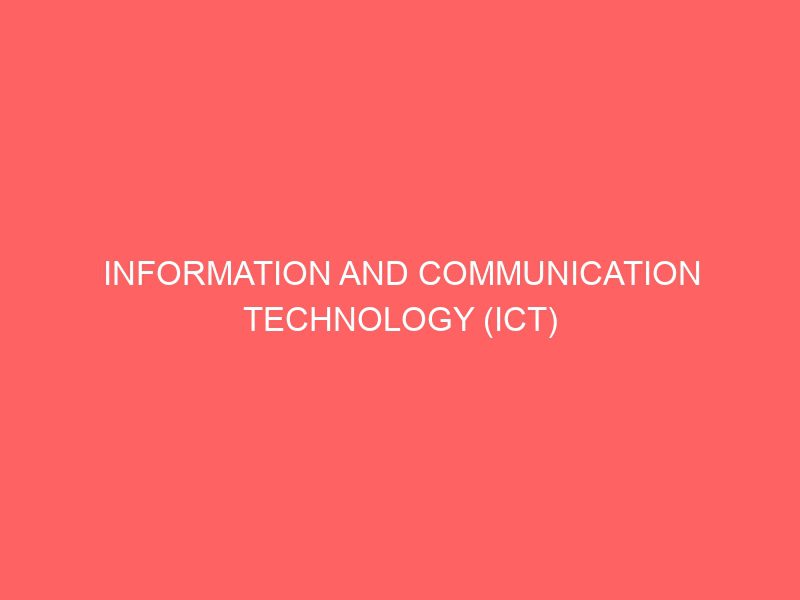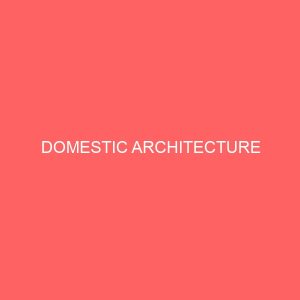Description
INFORMATION AND COMMUNICATION TECHNOLOGY (ICT) DEPLOYMENT IN ARCHITECTURAL FIRMS IN NIGERIA
Architectural practice has been in existence in Nigeria for more than fifty years and the
earliest introduction of computers by firms for operations began in the early 1980s.
Information and communication technology (ICT) usage is inevitable in all fields of
endeavors and for professionals in the present era. The study of ICT usage and deployment
therefore becomes imperative. This study aims at providing an understanding of the deployment of ICT in architectural firms in Nigeria. It specifically examines organizational
and ICT characteristics of the firms; the measure of fit between ICT tools deployed and tasks
engaged; the effect of training programmes on the availability of ICT proficient personnel; and the level of acceptance of Computer Supported Collaborative Work (CSCW) in
architectural firms in Nigeria. The Task-Technology Fit model (TTF) and an Extended
Technology Acceptance Model (TAM) were employed to test deployment of four design
technologies (AutoCAD, ArchiCAD, Revit Architecture and SketchUp) and the acceptance
of CSCW. The multistage sampling technique was used to derive the sample drawn from six
cities: Abuja, Kaduna, Maiduguri, Enugu, Lagos and Portharcourt were selected based on
documented evidence of having the largest number of firms in their zones. A total of 118
questionnaires were returned from a total of 159 distributed. This represents a 74.21% return
rate. The data collected were analysed using descriptive statistics, crosstabulations, Chi-
Square tests, exploratory factor analysis, Analysis of Variance (ANOVA) and multiple
regression analysis. The study revealed improvements in the quality and availability of ICT
systems in architectural firms in Nigeria as from 2001. Internet connectivity and Website
ownership is on the increase in architectural firms. Annual turnover of the architectural firms
has is positively correlated to the quality of installed systems. The study also found a
relationship between ownership of websites and the date of ICT introduction. The integrated
TTF/TAM test showed levels of fit between tasks engaged in architectural firms and the
design technologies deployed. The model tests explain between 41.4% – 52.1% of the
residual variation in the production of detailed system product. The coefficients of
determination and beta coefficients are significant to predict model fit of deployment.
Reasonable proficiency levels of the staff in the deployment of the available software and
technologies were confirmed. Furthermore firms are getting increasingly involved in
outsourcing as a service delivery strategy. The study revealed that few firms fund training
programmes within their organizations. Most of those that fund training programs commit
lower than a million naira to it annually. The study revealed that there is no significant
relationship between the availability of CAD/BIM proficient staff and the existence of
training programmes within the firms. It was also confirmed that there was no significant
relationship between the availability of CAD/BIM proficient staff and the training methods
employed by the firms. It was found that there was a significant relationship between the
availability of CAD/BIM proficient staff and the CAD/BIM proficient staff needed. The
interview responses suggest that the schools of architecture have done much towards
achieving the availability of CAD/BIM proficient staff. CSCW has been adopted by only
37.3% of the firms and the study revealed that perceived ease-of-use, security and the quality
of installed systems were predictors of the extended TAM model. In conclusion, the study
recommends that concerted efforts towards developing network infrastructure especially
broadband access can improve the practice of outsourcing and also have impact on CSCW.
Quality investment and commitment by technology companies and vendors, firms, the
government and other stakeholders in the area of ICT acquisitions, network security and the
development of user-friendly technologies will surely improve adoption and deployment of
ICT in architectural firms in Nigeria.
Title Page ……………………………………………………………………………………………..i
Declaration …………………………………………………………………………………………….ii
Certification ……………………………………………………………………………………………iii
Dedication ……………………………………………………………………………………………iv
Acknowledgements …………………………………………………………………………………………….v
Abstract …………………………………………………………………………………………….vi
Table of Contents …………………………………………………………………………………………….vii
List of Tables …………………………………………………………………………………………….xiii
List of Figures …………………………………………………………………………………………….xv
List of Plates …………………………………………………………………………………………….xvii
Chapter One: Introduction
1.1 Background to the Study………………………………………………………………………………..1
1.2 Statement of the Problem………………………………………………………………………………..3
1.3 Aim and Objectives ……………………………………………………………………………………….5
1.4 Research Hypothesis ……………………………………………………………………………………..5
1.5 Justification of the Research …………………………………………………………………………..6
1.6 Research Design…………………………………………………………………………………………….7
1.7 Scope of Study ……………………………………………………………………………………………..8
1.8 Limitation of Study………………………………………………………………………………………..8
1.9 Key Definitions and Concepts…………………………………………………………………………9
1.10 Summary ……………………………………………………………………………………………………..11
Chapter Two: Review of Literature
2.1 Introduction …………………………………………………………………………………………………12
2.2 Architecture and the Architect………………………………………………………………………..12
2.3 Scope of Architectural services ………………………………………………………………………14
2.3.1 Scope of Services …………………………………………………………………….p; 2.3.2 Normal Architectural Service: The Three Stages ……………………………………15
2.4 Architectural Practice in Nigeria ……………………………………………………………………..16
2.4.1 Architecture and Regulatory Institutions in Nigeria ………………………………..18
2.5 Historical Account from CAD to BIM ……………………………………………………………..19
2.5.1 The Advent and Development of the Computer ………………………………………19
2.5.2 Evolution and Development of CAD, CAAD and Graphic Packages………….20
2.5.3 Evolution of Communication Systems……………………………………………………22
2.6 The Real and the Virtual …………………………………………………………………………………23
2.7 ICT Applications in Architectural Firms …………………………………………………………..24
2.7.1 Areas of Applications of ICT in Architectural Firms…………………………………24
2.8 ICT Adoption and Deployment ………………………………………………………………………..25
2.8.1 General Administrative Application ………………………………………………………26
2.8.2 Core Architectural Applications …………………………………………………………….27
2.8.3 Computer Aided Design (2D and 3D CAD) …………………………………………..27
2.8.4 CAAD as Distinct from CAD ………………………………………………………………30
2.8.5 Digital Object Library (DOL) ………………………………………………………………30
2.8.6 Design and Virtual Modelling ………………………………………………………………30
2.8.7 Animations and Simulations ………………………………………………………………..32
2.8.8 5D Modelling………………………………………………………………………………………32
2.9 BIM and Its Significance to Architectural services………………………………………………33
2.9.1 Challenges of BIM Solutions…………………………………………………………………34
2.10 Web-Based Deployment………………………………………………………………………………….35
2.11 Human Resource for CAD, CAAD and BIM……………………………………………………..38
2.11.1 Outsourcing…………………………………………………………………………………………40
2.11.2 Training………………………………………………………………………………………………42
2.12 Hardware and System Requirements…………………………………………………………………44
2.13 Challenges of ICT Deployment in Nigerian Firms………………………………………………45
2.13.1 Security……………………………………………………………………………………………….46
2.13.2 Availability…………………………………………………………………………………………47
2.13.3 Accessibility……………………………………………………………………………………….48
2.13.4 Affordability………………………………………………………………………………………48
2.14 Productivity Gains from ICT Deployment…………………………………………………………49
2.15 Summary of Chapter……………………………………………………………………………………….50
Chapter Three: Theoretical/Conceptual Framework
3.1 Introduction ……………………………………………………………………………………………….52
3.2 Research Approaches and perspectives in the Study of ICT in Organizations………52
3.2.1 The positivist Perspective…………………………………………………………………..52
3.2.2 The Interpretive Perspective……………………………………………………………….54
3.2.3 The Critical Perspective……………………………………………………………………..54
3.3 Theoretical Framework for the Study …………………………………………………………….55
3.4 Technology Acceptance Model (TAM)…………………………………………………………..55
3.5 Task-Technology Fit (TTF) Model………………………………………………………………..57
3.6 Summary of Chapter…………………………………………………………………………………….60
Chapter Four: Research Methodoloour: Research Methodology
4.1 Introduction…………………………………………………………………………………………………61
4.2 Research Design…………………………………………………………………………………………..61
4.3 Research Population……………………………………………………………………………………..62
4.4 Subjects………………………………………………………………………………………………………62
4.5 The Sampling Frame…………………………………………………………………………………….62
4.6 Sampling Technique……………………………………………………………………………………..65
4.7 Sample Size ………………………………………………………………………………………………..66
4.8 Pilot Study…………………………………………………………………………………………………..69
4.9 Method of Data Collection……………………………………………………………………………..69
4.9.1 Questionnaire/Interview Design……………………………………………………………..70
4.9.2 Data Collection and Treatment……………………………………………………………….70
4.9.3 Field Work Details………………………………………………………………………………..77
4.11 Summary …………………………………………………………………………………………………….78
Chapter Five: Organization and Information and Communication Technology
Characteristics of Architectural Firms
5.1 Introduction…………………………………………………………………………………………………80
5.2 Period of Establishment of Firms…………………………………………………………………….80
5.3 Date of ICT Introduction……………………………………………………………………………….81
5.4 Number of Branches Operated………………………………………………………………………..82
5.5 Annual Turnover of Firms………………………………………………………………………………83
5.6 ICT Characteristics of Architectural Firms……………………………………………………….85
5.6.1 Availability of Websites…………………………………………………………………………85
5.6.2 Number of Available Workstations………………………………………………………….86
5.6.3 Quality of Installed Systems……………………………………………………………………87
5.6.4 Operating System Used…………………………………………………………………………..87
5.6.5 Availability of Internet Connectivity…………………………………………………………88
5.6.6 Forms of Internet Connectivity…………………………………………………………………89
5.6.7 Internet Service Providers (ISP)………………………………………………………………..89
5.6.8 Mode of Connectivity Deployed……………………………………………………………….90
5.7 Annual Turnover and Quality of Installed Systems……………………………………………..91
5.8 Website Availability and Date of ICT Introduction……………………………………………..94
5.9 Implications of Findings…………………………………………………………………………………..94
5.10 Summary……………………………………………………………………………………………………….95
Chapter Six: Task Technology Fit in the Deployment of Design Technologies in
Architectural Firms
6.1 Introduction……………………………………………………………………………………………….97
6.2 Task Significance in Architectural Firms………………………………………………………..97
6.3 Task Technology Fit Model………………………………………………………………………….99
6.4 Exploratory Factor Analysis (EFA) of TTF Constructs for Design Technologies…100
6.4.1 AutoCAD Deployment EFA………………………………………………………………101
6.4.2 ArchiCAD Deployment EFA……………………………………………………………..102
6.4.3 Revit Architecture Deployment EFA…………………………………………………..103
6.4.4 SketchUP Deployment EFA……………………………………………………………….104
6.5 Task-AutoCAD (TTF) Model………………………………………………………………………..105
6.5.1 Hypothesis Test…………………………………………………………………………………108
6.6 ArchiCAD TTF Models………………………………………………………………………………..111
6.6.1 Hypothesis Test…………………………………………………………………………………111
6.7 Revit (Architecture) TTF Models…………………………………………………………………..112
6.7.1 Hypothesis Test…………………………………………………………………………………113
6.8 SketchUp TTF Model…………………………………………………………………………………..114
6.8.1 Hypothesis Test…………………………………………………………………………………116
6.9 Implications of Findings………………………………………………………………………………..116
6.10 Summary…………………………………………………………………………………………………….118
Chapter Seven: Human Capital Availability and Capability of Architectural Firms
7.1 Introduction………………………………………………………………………………………………..120
7.2 Number of Staff in the Architectural Firms……………………………………………………..120
7.3 Staff with Architectural Training……………………………………………………………………121
7.4 Draughtsmen in Architectural Firms……………………………………………………………….122
7.5 CAD Literate Personnel………………………………………………………………………………..123
7.6 BIM Literate Personnel…………………………………………………………………………………123
7.7 Staff Proficiency Levels with Design Technologies………………………………………….123
7.7.1 Staff Proficiency Levels AutoCAD……………………………………………………..124
7.7.2 Staff Proficiency Levels ArchiCAD……………………………………………………..125
7.7.3 Staff Proficiency Levels Revit Architecture…………………………………………..126
7.7.4 Staff Proficiency Levels ” SketchUp…………………………………………………….127
7.7.5 Staff Levels of Proficiency in the deployment of the Internet…………………..128
7.7.6 Staff Proficiency Levels ” Autodesk Buzzsaw……………………………………….129
7.7.7 Staff Proficiency Levels ” Renderers…………………………………………………….130
7.7.8 Staff Proficiency Levels ” Other Software…………………………………………….131
7.8 Outsourcing in Architectural Firms………………………………………………………………….132
7.8.1 Adoption of Outsourcing……………………………………………………………………..133
7.8.2 Services Previously Outsourced……………………………………………………………133
7.8.3 Services Currently Outsourced……………………………………………………………..134
7.8.4 The Future: Services Considered for Outsourcing…………………………………..135
7.9.0 Existence of Staff Training Programmes………………………………………………………….136
7.10 Training Methods Employed…………………………………………………………………………..137
7.11 Funding for training programmes……………………………………………………………………138
7.12 Availability of CAD/BIM Proficient Staff and the Existence of
Training Programmes…………………………………………………………………………………….139
7.13 Availability of CAD/BIM Proficient Staff and CAD/BIM Staff Needed………….141
7.14 Availability of CAD /BIM proficient staff and Training Methods in
Architectural Firms……………………………………………………………………………………….142
7.15 Implications of Findings………………………………………………………………………………..144
7.16 Summary……………………………………………………………………………………………………..145
Chapter Eight: Acceptance of Computer Supported Collaborative Work in
Architectural Firms in Nigeria
8.1 Introduction…………………………………………………………………………………………………147
8.2 Adoption of CSCW in Architectural firms……………………………………………………….147
8.3 The Regression Analysis of the Extended TAM Model …………………………………….148
8.4 The Revised Extended TAM model…………………………………………………………………151
8.5 Implications of Findings…………………………………………………………………………………152
8.6 Summary……………………………………………………………………………………………………..152
Chapter Nine: Summary, Discussions and Conclusions
9.1 Introduction………………………………………………………………………………………………….153
9.2 Overview of the Study…………………………………………………………………………………..153
9.3 Summary of Findings…………………………………………………………………………………….156
9.4 Discussion…………………………………………………………………………………………………..158
9.5 Areas of Future Study……………………………………………………………………………………163
9.6 Contribution to Knowledge…………………………………………………………………………….163
9.7 Recommendations…………………………………………………………………………………………164
9.8 Conclusion……………………………………………………………………………………………………164
References……………………………………………………………………………………………………………..166
Appendices…………………………………………………………………………………………………………….178
LIST OF TABLES
Table 2.1 Report of the number of Architects, firms and firm/membership ratio…………19
Table 2.2 Major Design and Collaboration technologies and their Classification………..35
Table 4.1 Table showing the distribution of licensed architectural firms in the various
cities across the country (2004, 2006, 2008 and 2010)………………………………63
Table 4.2 Table showing the distribution of licensed architectural firms in the various
cities across the country with respect to geographical grouping (2008)……….64
Table 4.3 Table showing the sample of licensed architectural firms in the various
selected cities across the country…………………………………………………………….67
Table 4.4 Table showing the number, percentage of duly completed questionnaire and
overall response rate……………………………………………………………………………..69
Table 4.5 Definition of Variables………………………………………………………………………….74
Table 5.1 Correlation Matrix relating Seven Characteristics of Sampled
Architectural Firms ……………………………………………………………………………..84
Table 5.2 Annual turnover and quality of installed systems Cross tabulation……………..92
Table 5.3 Website Availability and Date of ICT Introduction Cross tabulation………….93
Table 6.1 Frequency of Tasks in Architectural Firms………………………………………………99
Table 6.2 Variables Extracted/Factor loadings for AutoCAD dataset………………………102
Table 6.3 Variables Extracted/Factor loadings for ArchiCAD dataset……………………..103
Table 6.4 Variables Extracted/Factor loadings for Revit Architecture dataset…………..104
Table 6.5 Variables Extracted/Factor loadings for SketchUP dataset……………………….105
Table 6.6 Model Summary for AutoCAD TTF/TAM Test……………………………………..107
Table 6.7 Model Summary for ArchiCAD TTF/TAM Test……………………………………110
Table 6.8 Model Summary for Revit Architecture TTF………………………………………….115
Table 6.9 Model Summary for SketchUp TTF/TAM Test……………………………………..124
Table 7.1 Staff Mean Proficiency Levels in the Available ICT Tools………………………133
Table 7.2 Average Percentage of firms’ staff per Proficiency Level………………………..149
Table 8.1 Model Summary for CSCW TAM Test…………………………………………………143
LIST OF FIGURES
Figure 2.1 Operational Structure of AutoCAD Showing the Link between Graphic,
Numeric and Visual Data in the Production of a Complete CAD
Document……………………………………………………………………………………………29
Figure 2.2 Graphical Description of the relationship between the Internet, Extranet and
Intranet………………………………………………………………………………………………37
Figure 2.3 Personnel levels, Roles and relationships within an ICT driven Firm………….39
Figure 3.1 Technology Acceptance Model………………………………………………………………55
Figure 3.2 Extended Technology Acceptance Model………………………………………………..56
Figure 3.3 Task-Technology Fit Model…………………………………………………………………..57
Figure 3.4 Integrated TAM/TTF Model………………………………………………………………….58
Figure 3.5 Integrated TAM/TTF Model for the study showing the various constructs….59
Figure 4.1 Chart showing the distribution of Architectural firms in the sample…………..78
Figure 5.1 Architectural Firms’ Year of Establishment ……………………………………………81
Figure 5.2 Architectural Firms’ Date of ICT Introduction ……………………………………….82
Figure 5.3 Number of Branches Operated by Architectural Firms……………………………..83
Figure 5.4 Architectural Firms’ Annual Turnover……………………………………………………83
Figure 5.5 Availability of Websites by Architectural Firms………………………………………85
Figure 5.6 Number of Available Workstations in Architectural Firms………………………..86
Figure 5.7 Architectural Firms’ Quality of Installed Systems ……………………………………87
Figure 5.8 Operating System Utilized by Architectural Firms……………………………………88
Figure 5.9 Availability of Internet Connectivity in Architectural Firms………………………88
Figure 5.10 Forms of Connectivity Employed by Architectural Firms………………………….89
Figure 5.11 Mode of Connectivity Deployed by Architectural Firms……………………………91
Figure 5.12 Annual turnover and quality of installed systems……………………………………..93
Figure 5.13 Bar Chart showing Website Availability and Date of ICT Introduction……..94
Figure 6.1 Architectural Firms’ Percentage Usage of design software……………………..100
Figure 7.1 Number of Staff in the Architectural Firms……………………………………………121
Figure 7.2 Number of staff with architectural training in the firms………………………….122
Figure 7.3 Staff Level of Proficiency in the deployment of AutoCAD…………………….125
Figure 7.4 Staff Level of Proficiency in the deployment of ArchiCAD…………………….126
Figure 7.5 Staff Level of Proficiency in the deployment of Revit Architecture…………127
Figure 7.6 Staff Level of Proficiency in the deployment of SketchUP……………………..127
Figure 7.7 Staff Level of Proficiency in the deployment of Autodesk Buzzsaw………..129
Figure 7.8 Staff Level of Proficiency in the deployment of Renderers……………………..130
Figure 7.9 Staff Level of Proficiency in the deployment of other software……………….131
Figure 7.10 Percentage of firms Outsourcing Major Tasks………………………………………..135
Figure 7.11 Existence of Training Programmes in Architectural Firms……………………….136
Figure 7.12 Method of Training Programmes in Architectural Firms………………………….138
Figure 7.13 Funding for Training Programmes………………………………………………………..139
Figure 7.14 Availability of CAD/BIM Proficient Staff and CAD/BIM Staff Needed…..142
Figure 8.1 Adoption of CSCW by Architectural Firms……………………………………………148
Figure 8.2 Extended Technology Acceptance Model for the Acceptance/
Adoption of CSCW in Architectural Firms in Nigeria……………………………..151
LIST OF PLATES
Plate 1 A rendered AutoCAD view of a proposed State Assembly Complex…………27
Plate 2 A rendered AutoCAD view of a proposed State Assembly Complex………….28
Plate 3 A rendered Revit Architecture model ……………………………………………………33
Plate 4 An Architect designing on a desktop system in the firms studio……………..109
Plate 5 Arrangement of the Workstations in the Firms Studio…………………………..140
Plate 6 Accommodation for Six CAD/BIM Proficient Staff in the Firms Studio…143








Lorna Burdett –